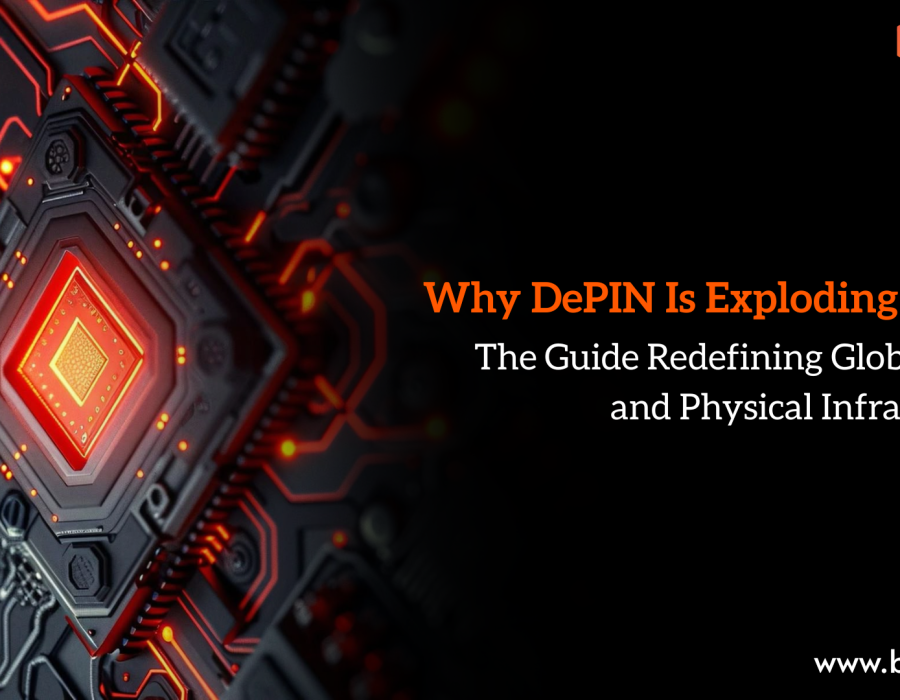The DePIN boom isn’t just another Web3 trend; it’s becoming the moment everyone is paying attention to. 2026 marks a turning point because digital and physical networks are finally coming together in a way that feels practical, valuable, and real.
From community-powered infrastructure to token-driven rewards, DePIN is unlocking a new model of how devices, data, and connectivity should work. And this shift is happening faster than anyone expected.
How DePIN Connects the Digital and Physical Worlds
DePIN connects the digital and physical worlds by turning real-world devices like sensors, hotspots, storage units, or compute nodes into part of a shared, blockchain-powered network. Instead of relying on big companies to run everything, DePIN lets everyday users supply infrastructure and earn rewards for supporting the system.
This model is growing fast because it removes the gap between online networks and physical infrastructure. With the help of DePIN Development Services, businesses can now build applications that use real devices, real data, and real value, all connected through secure decentralized technology.
Key Technologies Powering DePIN’s 2026 Explosion
The rise of DePIN in 2026 isn’t random. It’s driven by powerful technologies that finally make decentralized physical networks practical and scalable. These technologies help DePIN move from a basic idea to a real infrastructure model used in the real world.
How each core technology supports this growth:
IoT Devices
Physical sensors, routers, hotspots, cameras, and hardware feed real-time data into DePIN networks, making them smarter and more useful.
Blockchain Systems
Every actionfrom device activity to data sharing, is recorded securely, creating trust without needing a central company.
Edge Computing
Processing data near the source reduces delays, improves speed, and supports applications like mobility, mapping, and smart cities.
AI Automation
AI helps manage thousands of devices, optimize performance, detect issues, and make the network run smoothly with less human control.
Token Incentive Models
Users and businesses earn rewards for providing devices, bandwidth, storage, or compute power, which keeps the network growing.
Proof-of-Physical-Work (PoPW)
This verifies that real devices are truly performing tasks, preventing fake activity and ensuring honest contribution.
Real-World Impact: Industries Being Transformed Right Now
DePIN is no longer just a concept; it’s already changing how major industries operate today. By using community-powered infrastructure instead of centralized systems, DePIN brings faster services, lower costs, and more real-world reliability. Many sectors are now adopting this model because it offers both technical benefits and economic rewards.
The major industries being transformed right now:
Wireless & Connectivity:
Community-run hotspots and small devices are replacing traditional telecom towers, giving people cheaper and wider internet access through decentralized networks.
Cloud Storage & Data:
Platforms powered by users’ spare storage allow businesses to store data securely without paying huge fees to big cloud companies.
Compute & GPU Power:
DePIN networks pool unused computing power from around the world, supporting tasks like AI training, video rendering, and large-scale processing at lower costs.
Mobility & Mapping:
Cars, scooters, drones, and dashcams feed live data into decentralized maps, making navigation smarter, real-time, and more accurate.
Energy & Smart Grids:
Solar panels, batteries, and microgrids can connect to DePIN systems, letting users sell extra energy and support more sustainable power networks.
Supply Chain & Asset Tracking:
Sensors and tags track goods across warehouses and transport routes, giving real-time updates and preventing data tampering or manipulation.
What Do Users, Developers & Investors Really Want to Know About DePIN?
Most people ask the same question: “Why is DePIN suddenly important?” Users want to know how it provides better services at lower costs. Developers want tools that make building DePIN apps easier and faster. Investors mostly look for real-world impact and long-term value. In simple terms, everyone wants proof that DePIN solves real problems—not just creates another Web3 trend.
Conclusion: Why DePIN Is Becoming the Backbone of Future Infrastructure
DePIN is quickly becoming the backbone of future infrastructure because it blends real devices, real data, and real value into one decentralized system. What once seemed experimental is now shaping industries like wireless, compute, mobility, storage, and energy in practical and measurable ways.
With companies like Bitdeal, a leading DePIN Development Company, offering powerful solutions, businesses can now build real-world networks that scale faster and operate smarter. As adoption grows, DePIN is set to redefine how the world connects, communicates, and builds infrastructure.





Comments